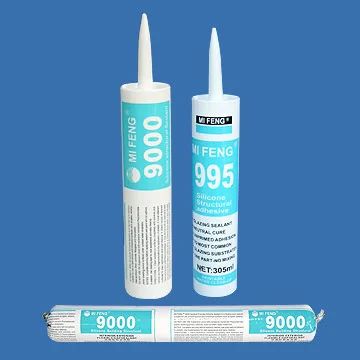
Structural Sealant
Structural sealant transfers the external and internal forces that the bonded material is subjected to. It does not perform the function of waterproofing like weatherproof adhesive.
BAIYUN SS922 Two Parts Super Performance Silicone Structural Sealant is a neutral curing silicone sealant that has been designed and tested for structurally glazed curtain wall applications. It has excellent unprimed adhesion to a wide variety of substrates.
Adhesion
The adhesion of Structural Sealant to the substrate is one of the most important factors affecting its performance. A high level of adhesion ensures the structural adhesive can transfer the load from the Structural Sealant bonded materials to the supporting structure, thereby ensuring the stability of the structures and its overall strength.
Structural adhesives are formulated to offer excellent adhesion to a wide variety of substrates. They also have low shrinkage and resistance to a number of chemicals. Moreover, they can withstand high temperatures and work well in poor weather conditions.
However, it is necessary to consider construction tolerances when selecting a structural sealant for a particular project. If there is a mismatch between the specified and actual construction tolerances, this may result in the insufficient bonding of the structural adhesive. This can lead to premature failure of the joint, resulting in loss of design load capacity.
Structural sealants are available in a range of formulations and packaging options to meet varying project needs. They can be applied manually or via an automated process, and can be dispensed using a range of applicators including cartridges, syringes, dual-cartridges, and soft-squeeze bottles. They are ideal for bonding, sealing, and assembly applications in a range of industrial and commercial design applications, including gasketing and flange sealing.
Durability
Structural sealant is designed to transfer loads from glass and metal framing members to the structure. It should also resist ageing, fatigue and corrosion. The durability of structural sealant can be measured using shear and tensile tests, accelerated weathering and life cycle testing. In the accelerated weathering test, the sealant is exposed to several cycles of alternating shear and tensile load in order to simulate a real-life exposure. The test measures the ability of the sealant to withstand this stress and the effects of aging on the material properties.
During the mechanical characterisation the accessible side of the sealant bead is inspected for cracks and notches, whereas the shear and tensile strength are tested by cutting the system specimens into small-scale specimens. For this purpose, the system specimens were cut into two shear and tensile specimens per series (see figure 5).
As shown in figure 6 the dynamic moduli decrease mostly during the first climatic cycles due to stress relaxation of the filled silicone elastomers. Afterwards the course of all the moduli follows the steady state, which indicates that the system is capable of bearing all the load combinations imposed during the test. Moreover, all the specimens pass the ETAG002-1 initial mechanical strength requirement without spontaneous failure, which shows the high performance of the sealant.
Flexibility
A preformed flexible sealant’s ability to expand and contract with a building substrate is an important attribute for many types of specialist applications. This flexibility means the sealant will move Structural Sealant with the substrate rather than cracking and breaking, making it ideal for sealing joints in areas of expansion and contraction.
Structural Sealant can be used for a variety of specialist applications, from sealing voids to bonding and filling small gaps. This is particularly useful for securing the edges of glazed components and infill panels in curtain wall frames. It can also be used to create an air-and-water barrier.
Appropriate sealant selection, careful joint preparation and mindful sealant placement are imperative to the functionality and watertightness of many precast concrete structures. This is especially true for precast concrete structures that are designed to accommodate a wide range of architectural elements and materials.
The key performance criteria in determining Safety in Use are the sealant’s initial mechanical strength and residual tensile strength. These key properties are established by testing specimens of the sealant under both constant extension and swelling compression loading. A number of FEA studies have been undertaken to explore these systems, with an emphasis on comparing the analytical structure of the sealant under dynamically repeated constant tensile loads with the analytical structure under constant swelling compression loads.
Moisture Resistance
Structural Sealant must be able to hold together and resist the movement of the substrate it is bonded to. This means that it must be able to take extension, compression, and transverse and longitudinal movements. It must also be able to resist the effects of weathering. This includes exposure to sunlight, acid rain, ozone, and extreme temperatures.
It is important that a structural silicone adhesive is able to withstand the stress that it will be subjected to over its service life, which could exceed 50 years. This is why it must have a high strength (compressive, steel-steel positive tensile bonding strength, shear) and elasticity. This is especially important if the structural adhesive is used for façade construction, where it will be exposed to very large and complex stresses, which are directly related to safety.
A structural silicone sealant must be able to handle primary and secondary loads, including shear and tensile stress, abrasion, and thermal movement. This is why designers typically limit the allowable stress to a maximum of 138 kPa (20 psi). This is an empirical value, which takes into account the risk to building occupants of sealant failure and defenestration of glazing materials, as well as the need for high factors of safety.

